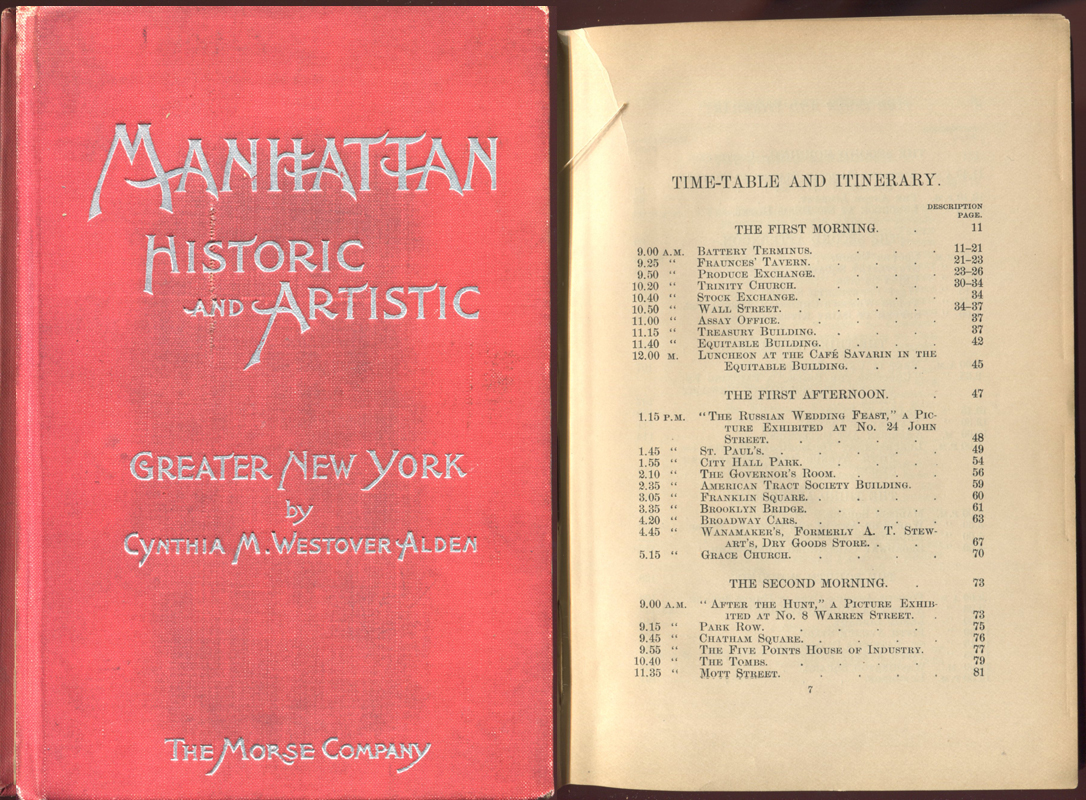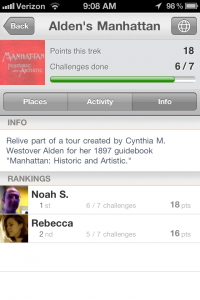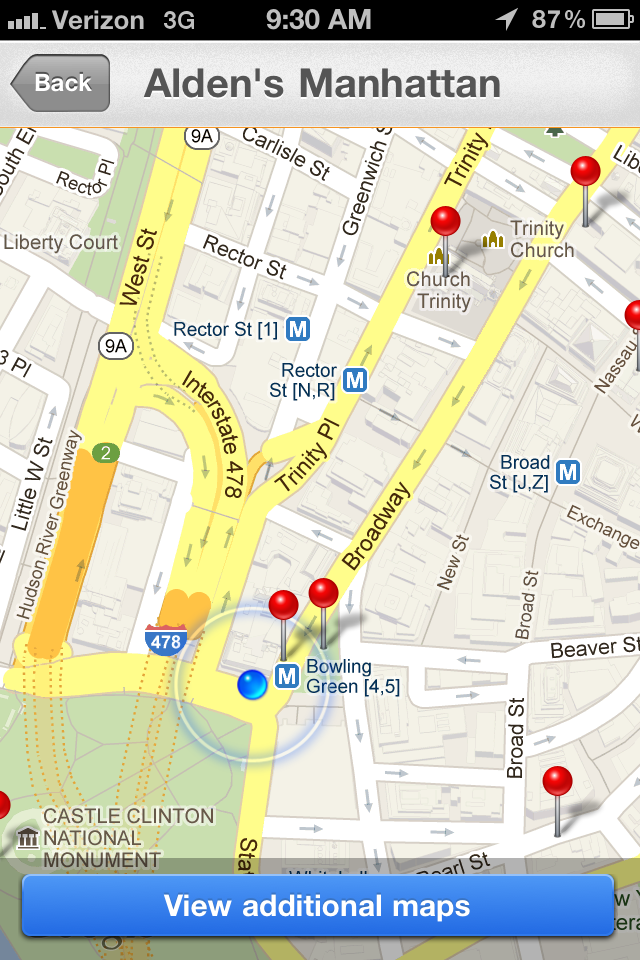Each year, over 40 million people travel to see the sights in New York City. I see tourists everyday; they arrive by bus, train, and plane, find a place to stay, take their chances on the subway and/or hail taxi cabs, and spend time visiting museums, monuments, restaurants, and bars. Two years ago as I started researching nineteenth-century guidebooks for a digital exhibition project with a colleague, I began to wonder: Do these visitors realize they are participating in a relatively new phenomenon, visiting many of the same sites as their intrepid nineteenth-century counterparts? Do New Yorkers realize how much tourism in the nineteenth century shaped their city? And in what ways could historians engage locals and visitors with that information?
I was able to address that last question when I took a course that encouraged exploring various modes of displaying and curating artifacts through digital media projects. My first concern was the content: How could I discuss the social lives of certain monuments, emphasize that the city was rapidly changing at the end of the nineteenth century, and refer to key concepts in the history of urban tourism (e.g. transportation, sightseeing)? Since I continued studying those nineteenth-century guidebooks for my master’s qualifying paper, I chose my favorite to serve as the basis for the project. Manhattan: Historic and Artistic, written by Cynthia M. Westover Alden and published in 1897, comes close to the type of guidebook that tourists use today. It has helpful maps, an itinerary for six-day trip complete with site-specific information, and a brief history of the city for new visitors.

Why create a playful mobile experience to teach history?
My next thought was of my audience: how could I inspire a sense of exploration in both visitors and locals? Then presentation: what platform makes the most sense for displaying site-specific information about urban tourism and guidebooks? It made sense to choose a mobile platform, since guidebooks were the original mobile information device for visitors (which is why they were often called “handbooks” in the nineteenth century). The benefit in creating a scavenger hunt is that engaging users in a playful and informative experience would give them a motive to travel to the different locations mentioned in Manhattan: Historic and Artistic. Learning about the city and the history of tourism would be integral to completing challenges because I could design them for that purpose. I planned on designing something that would function like an augmented reality version of an historical plaque, with players having to find the historical “plaques” and engage with them through a challenge, and then be rewarded with part of a story or perhaps a digital version of the original guidebook.
Why SCVNGR? How does it work?

I chose to experiment with the location-based gaming platform called SCVNGR because it was an easy and accessible way to create a playful, mobile experience based on specific historic sites. Players check into locations (like with Foursquare or Facebook), but also complete challenges at those places and earn points. Most people access SCVNGR as an iPhone or Android application, but there is also limited SMS functionality, so the application is fairly accessible and comes with its own user base.
Third party applications like SCVNGR give people and organizations with limited resources the opportunity to deliver content digitally and tap into a new audience. Historians, teachers, and museum professionals would only need to make an account and watch some tutorial videos to get started. But like all third party applications, SCVNGR has a set structure and design that their “builders” might not have chosen for their own projects. This presents a challenge for builders to determine if SCVNGR will further or compromise their project’s goals.
For a walkthrough of both builder and player access in SCVNGR, check out this Prezi I made documenting my experience creating “Alden’s Manhattan.” Feel free to zoom in to read specific challenges or descriptions, and click “more” for the fullscreen option. [EDITOR NOTE : PREZI NO LONGER AVAILABLE]
Limitations and challenges SCVNGR builders face
For people working at museums or historic sites, SCVNGR imposes strict limitations that should be considered when developing a series of challenges linked under a common theme, or “trek.” I encountered these limitations as I created the trek “Alden’s Manhattan,” which is playable with seven active challenges.
- Word Count: SCVNGR has a strict word count limitation for each portion of a trek and challenge. Descriptions, instructions, messages, and photographs are all limited in size to prevent users from scrolling through content. Overall this is a beneficial challenge since players are on their mobile phones, but it is still difficult when trying to convey historical concepts!
- Challenge Types: Builders can choose from four different challenge types: open responses, specific text responses, and photo and QR code challenges. When designing challenges in a trek, builders must consider the best challenge types for different content. The photo challenge provides a lot of flexibility – if players are meant to do something at a place, the builder can request players to take a photograph of that action. For example, in the trek I created, players must pay their respects to Robert Fulton in the Trinity Church Cemetery (see – I did get the theme of transportation in there!). The only way to know if players actually did so is to have them take a photograph of the process.
- Rewards: Users can only redeem points for rewards at specific locations, meaning that there is no way for builders to reward users for completing SCVNGR “treks” spread across various locations. My idea of rewarding those who completed the trek I created with a .pdf version of the guidebook (large .zip file) Manhattan: Historic and Artisticwas not possible.

SCVNGR players can locate challenges by using the Google Maps interface. Additional maps can be added by builders to aid players (e.g. map of a museum wing).
- Maps: The trek’s challenge locations are laid out on Google Maps interface in SCVNGR. There is an additional map feature that seemed useful at first, but the additional maps cannot be captioned or labeled, so builders must change the map images to include a title or caption. Maps cannot be rectified with Google Maps to show locations of specific challenges on the custom map. So I could not have players explore the trek using one of the maps in Manhattan: Historic and Artistic.
- Money: SCVNGR is free for small businesses, but costs money for everyone else building more than five challenges. They do not list the cost of their various builder packages on their website; companies and institutions must contact them for a quote. I received an indie builder grant from SCVNGR to activate the challenges for my project, and the SCVNGR staff was very friendly and helpful in processing that application. However, if a museum or historic site wanted to create multiple SCVNGR treks for their audience, they would have to pay.
- Audience: Unless builders have the opportunity to market their treks, they are depending upon SCVNGR’s native audience to discover and do their challenges. Unfortunately SCVNGR doesn’t have a robust audience in the same way that Foursquare does, limiting the potential for discovery through the application itself. The few people that did my trek (aside from my boyfriend Noah, who graciously playtested the trek) were either ‘bots or cheaters, since they did not do any of the challenges properly. They took blank photographs and answered open response questions generically, although they could not complete the specific text challenges I built. That said, SCVNGR seems to have had some success being used at special events and conferences.
Advice for using SCVNGR and other third party social applications
- Be flexible and explore the limitations of the platform before making the decision to use the application. My willingness to engage with a third party application knowing that limitations were inevitable made the process less frustrating than it might have been for someone with strict goals and ideas for their project.
- Weigh the benefits of the application’s convenience against the limitations it would impose on project’s content. In the case of my project, the content and my goals for “Alden’s Manhattan” were not compromised by SCVNGR’s platform, so its convenience was well worth the effort in navigating its limitations.
- Compare your goal audience with the application’s user base. My target audience was any adult with a smartphone in the downtown Manhattan area, so SCVNGR’s audience matched with my own. Had I been developing a scavenger hunt for elementary school students learning about New York’s history, I would probably need to reconsider using SCVNGR since most young children don’t have smart phones.
- Playtest any trek or challenges that you create, and think about the weather. Is your trek doable in one afternoon or multiple sessions? Is it only possible to complete in the summer? Will people avoid your trek when it’s raining?
- Set reasonable goals for usage based on similar projects that others have created with the same application and evaluate the success of your project based on those goals.
- Reflect on the entire process to better inform your next project!
And most importantly, good luck and have fun!


1 Comment